generalist parasite; feeds on host hemolymph
Pyemotes Amerling, 1862
Superorder Acariformes » Order Trombidiformes » Suborder Prostigmata » Infraorder Eleutherengona » Hyporder Heterostigmata » Family Pyemotidae » Genus Pyemotes
Pyemotes Eccoptogasteri pruni Amerling, 1861 nom. nud. (=? Pyemotes scolyti Oudemans, 1936Oudemans, 1936:
Oudemans, A. C. 1936. Neues über Pediculoides Targ. Tozz. 1878 In Festschrift zum 60. geburtstage von professor dr. Embrik Strand. Ordinarius für Zoologie und Direktor des Systematisch-Zoologischen Instituts und der Hydrobiologischen Station der Universität Lettlands, Riga; Dr. rer. nat. h. c., M.A.N., F.R.E.S., F.L.S., F.Z.S., etc. Vol. 1, ed. E. Strand, 391-404. Riga: Izdevniecība "Latvija".)
Pediculoides in historical literature
Sometimes called itch mites for their ability to bite humans; for example, the oak leaf gall mite or itch mite (Pyemotes herfsi) and straw itch mite (Pyemotes tritici).
Adult: Tarsustarsus:
Terminal segment (also known as podomere or palpomere) of legs or palps. In Parasitoformes it can be subdivided into telotarsus and basitarsus.
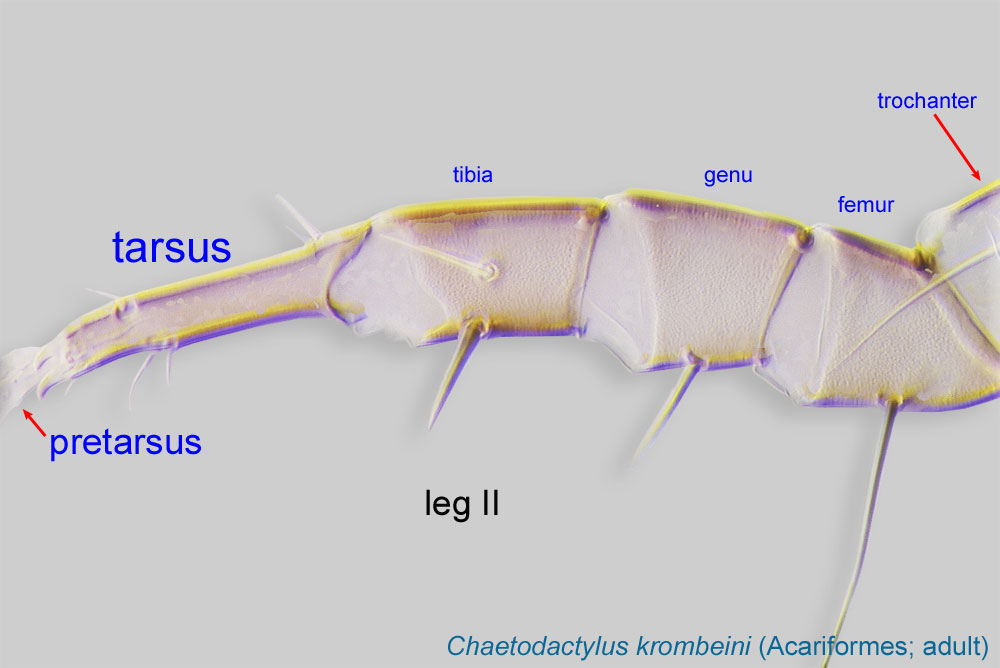 I with single claw (Figs. 2, 6). TrochantersTrochanter:
I with single claw (Figs. 2, 6). TrochantersTrochanter:
Leg or palp segment (also known as podomere or palpomere) between femur and coxa. In Acariformes this is the most basal movable leg segment (or podomere) forming a joint with the body.
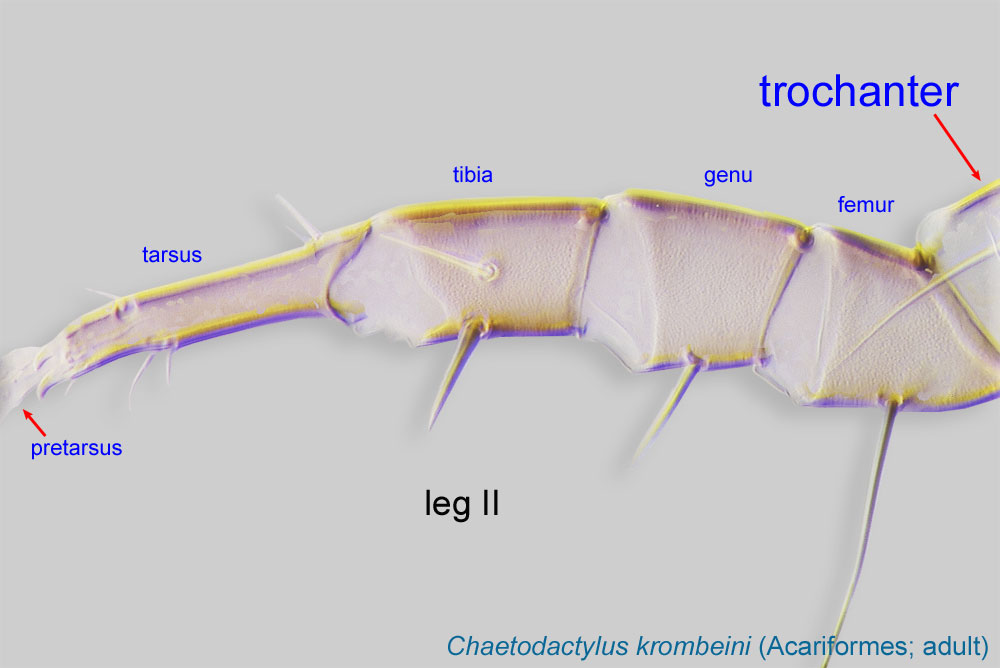 of legs I-IV each with 1 seta (Figs. 2, 6). Trochantertrochanter:
of legs I-IV each with 1 seta (Figs. 2, 6). Trochantertrochanter:
Leg or palp segment (also known as podomere or palpomere) between femur and coxa. In Acariformes this is the most basal movable leg segment (or podomere) forming a joint with the body.
 IV subtriangular (Figs. 2, 6). Coxisternal (=coxal) plates I-II together with maximally 4 pairs of setae (Fig. 2).
IV subtriangular (Figs. 2, 6). Coxisternal (=coxal) plates I-II together with maximally 4 pairs of setae (Fig. 2).
Female: Femurfemur:
Leg or palp segment (also known as podomere or palpomere) between genu and trochanter. In ParasitIformes can be subdivided into telofemur and basifemur.
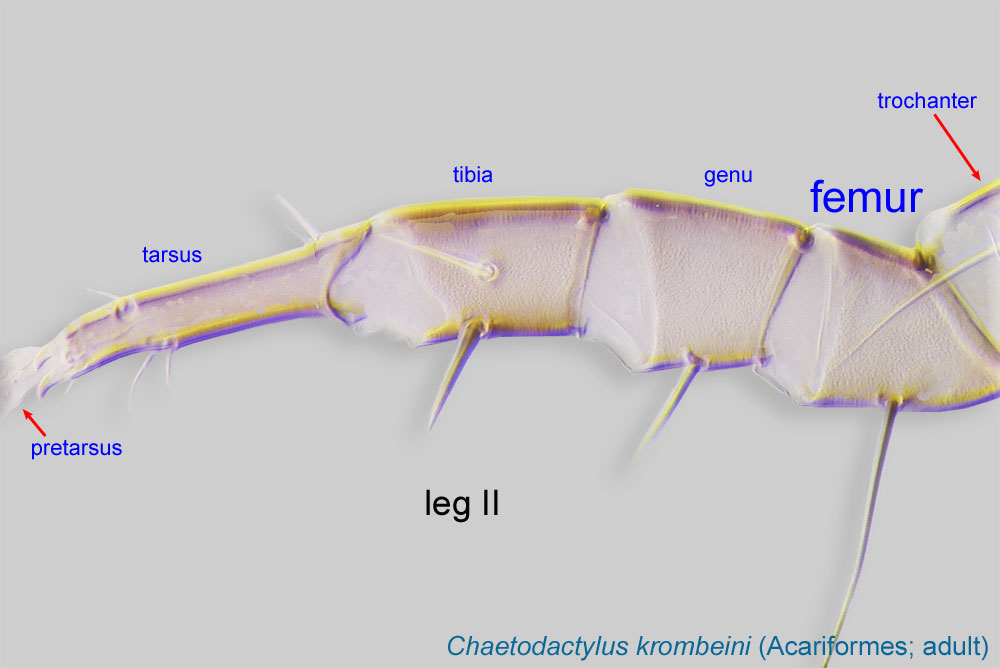 and genugenu:
and genugenu:
Leg or palp segment (also known as podomere or palpomere) between tibia and femur.
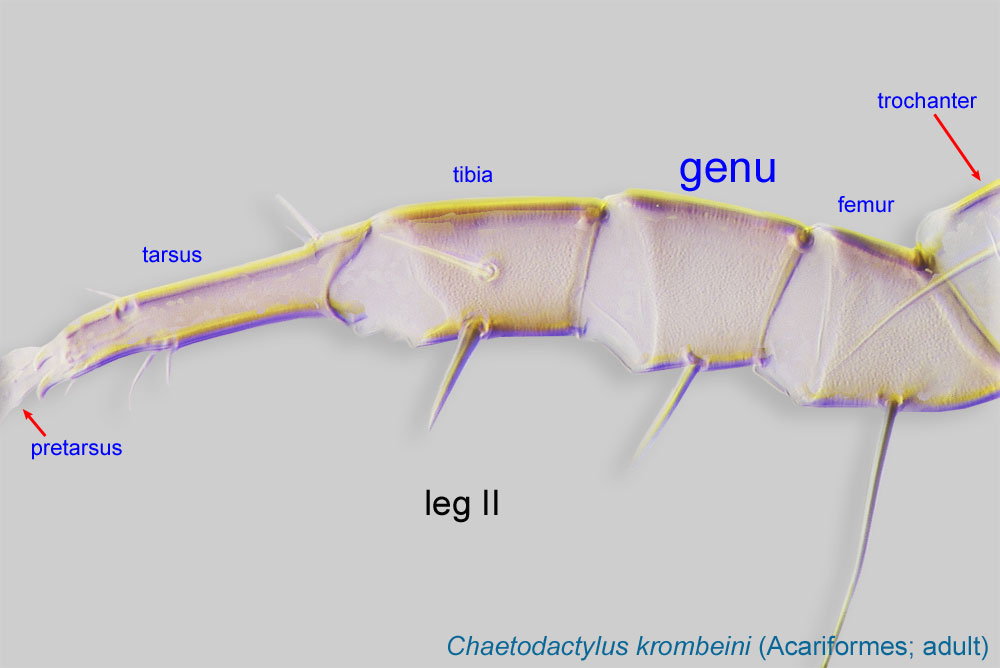 of legs IV separate (Figs. 2, 6). Tarsustarsus:
of legs IV separate (Figs. 2, 6). Tarsustarsus:
Terminal segment (also known as podomere or palpomere) of legs or palps. In Parasitoformes it can be subdivided into telotarsus and basitarsus.
 IV with paired claws and empodiumempodium:
IV with paired claws and empodiumempodium:
Here used only when empodial claw is not claw-like, i.e., it is pad-like or membranous.
(Fig. 2). Coxisternal plates I lacking discoid structures (Fig. 2). Coxisternal plates III-IV separated from each other medially by soft cuticle that bears a separate triangular sternal plate (Fig. 2).
Male: Legs IV 5-segmented (trochanter, femurfemur:
Leg or palp segment (also known as podomere or palpomere) between genu and trochanter. In ParasitIformes can be subdivided into telofemur and basifemur.
 , genugenu:
, genugenu:
Leg or palp segment (also known as podomere or palpomere) between tibia and femur.
 , tibiatibia:
, tibiatibia:
Leg or palp segment (also known as podomere or palpomere) between tarsus and genu.
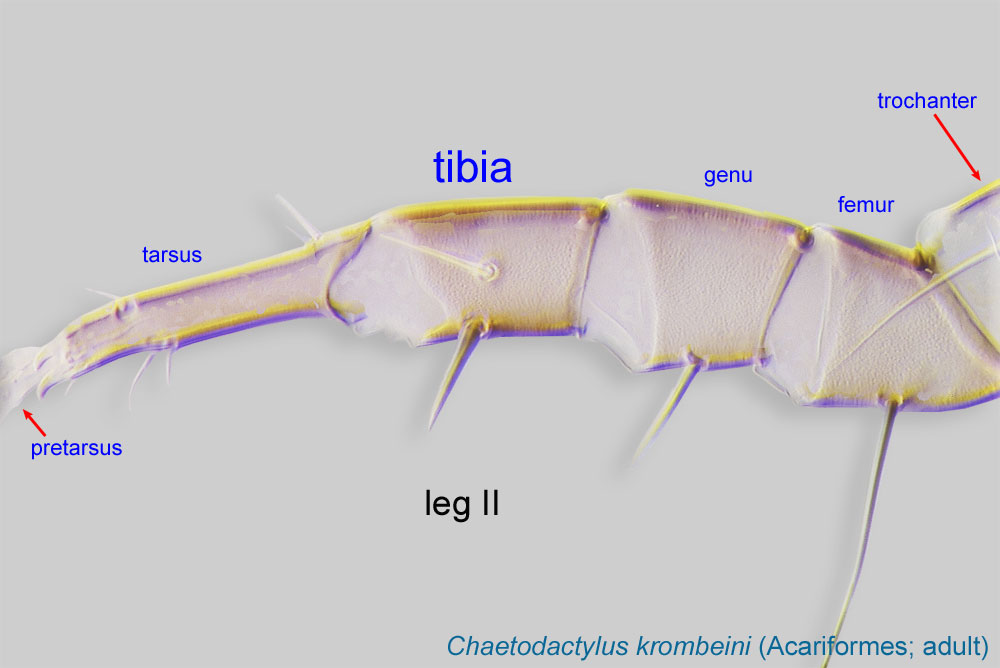 , and tarsustarsus:
, and tarsustarsus:
Terminal segment (also known as podomere or palpomere) of legs or palps. In Parasitoformes it can be subdivided into telotarsus and basitarsus.
 ), with single claw; differentiated from legs III in being somewhat stouter and ending with a single sessile claw (Fig. 6). Gnathosomagnathosoma:
), with single claw; differentiated from legs III in being somewhat stouter and ending with a single sessile claw (Fig. 6). Gnathosomagnathosoma:
Division of body anterior to the propodosoma bearing two pairs of appendages (palps and chelicerae).
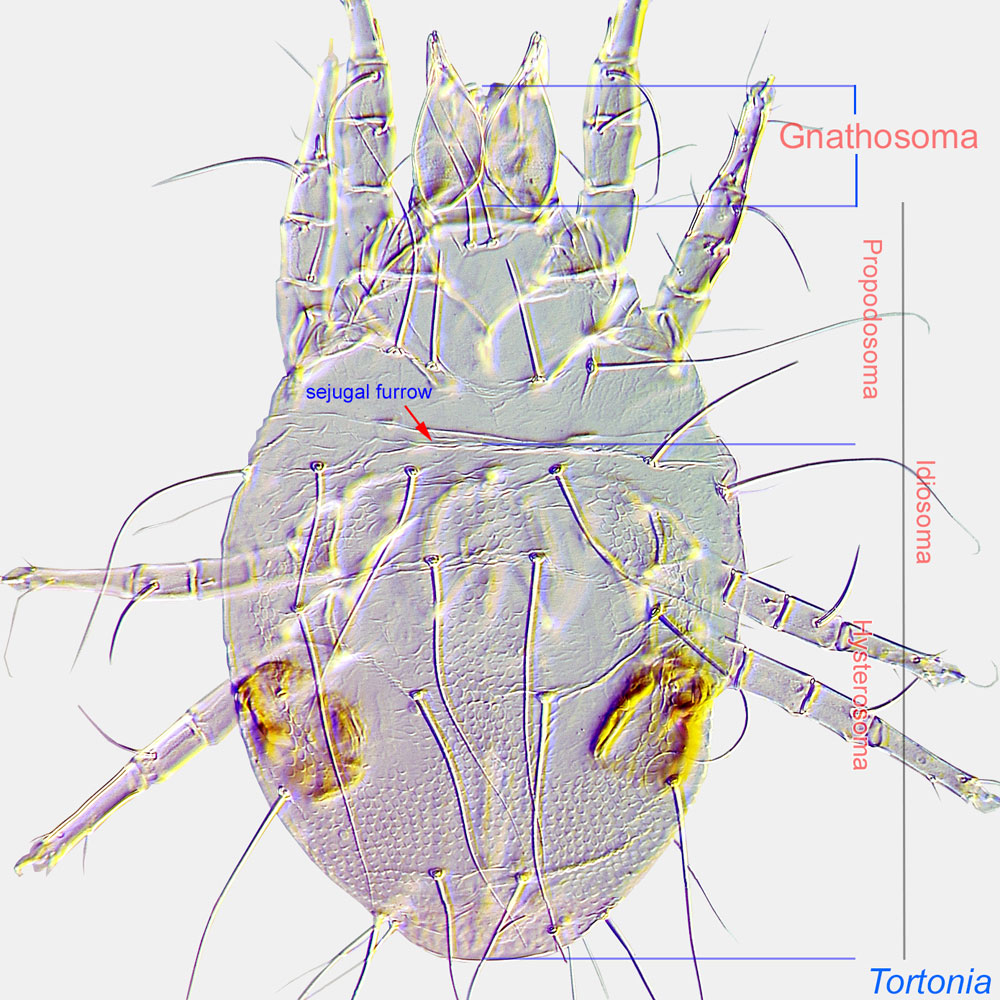 not reduced, with palpspalp:
not reduced, with palpspalp:
Second (after chelicera) paired appendage of the gnathosoma. Has a sensory function, but may be variously modified for other functions (e.g., raptorial, attachment to host, or filtering).
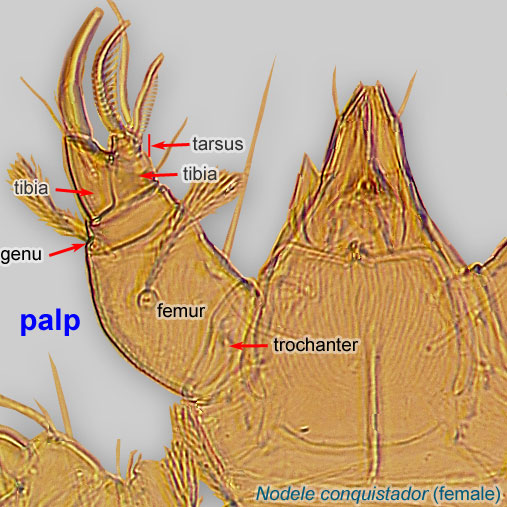 (Fig. 6).
(Fig. 6).
The most recent key is available in Cross et al., 1981Cross et al., 1981:
Cross, E. A., J. C. Moser amp; G. Rack. 1981. Some new forms of Pyemotes (Acarina: Pymotidae) from forest insects, with remarks on polymorphism. International Journal of Acarology 7: 179-202.. A key to Pyemotes species associated with bees is available from the bee-associated mites website.
Cosmopolitan, but species attacking bees have not yet been found in the Afrotropics.
Apis, Anthophora (Apidae), Frieseomelitta, Melipona, Tetragonisca (Apidae: Meliponini), Hoplitis, and Megachile (Megachilidae)
facultativefacultative:
can complete entire life cycle without bees or their close relative, wasps
The genus Pyemotes includes polyxenous (multi-host) or monoxenous (single-host) insect parasites. Some species of Pyemotes are natural enemies of forest insects or stored product insects. The genus is divided into two groups, scolyti and ventricosus (Cross et al., 1981Cross et al., 1981:
Cross, E. A., J. C. Moser amp; G. Rack. 1981. Some new forms of Pyemotes (Acarina: Pymotidae) from forest insects, with remarks on polymorphism. International Journal of Acarology 7: 179-202.).
Species of the scolyti-group are phoreticphoretic:
Pertaining to phoresy; using another organism (i.e., a host) for dispersal to new habitats. Phoresy can be distinguished from parasitism because feeding typically does not occur during phoresy.
on bark beetles (Curculionidae: Scolytinae) and are not associated with bees.
Species of the ventricosus group are not known to be phoreticphoretic:
Pertaining to phoresy; using another organism (i.e., a host) for dispersal to new habitats. Phoresy can be distinguished from parasitism because feeding typically does not occur during phoresy.
. At least some species possess venom. The mites inject neurotoxin-containing saliva into prey, which causes paralysis and eventual death, and enables the gravid female mites to feed on the host's hemolymph (Krczal, 1957Krczal, 1957:
Krczal, H. 1957. Sytstematik und Ökologie der Pyemotiden. In Sytstematik und Ökologie Mitteleuropäischer Acarina. 1(1). ed. H.-J. Stammer, 385-823. Leipzig: Akademissche Verlaggesellschaft.). During feeding the female's posterior idiosomaidiosoma:
Body not including the gnathosoma.
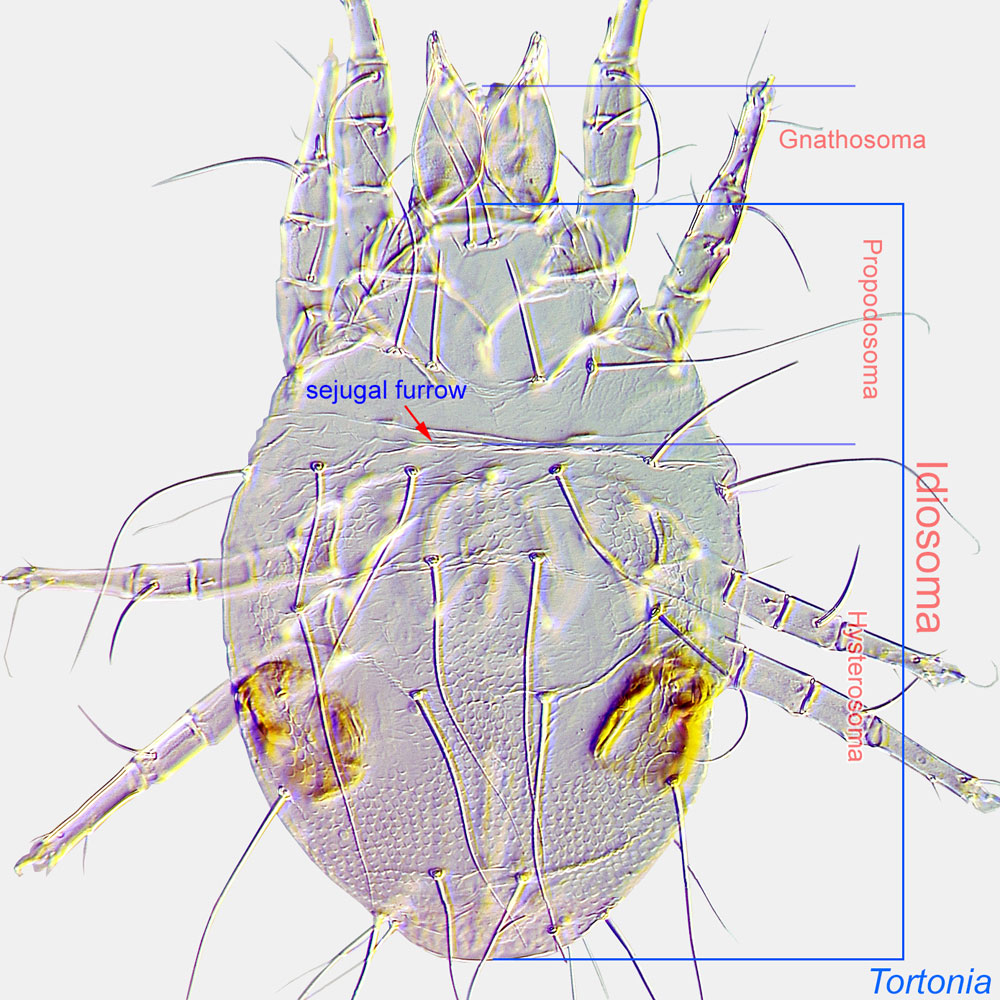 becomes enlarged and ball-shaped (physogastry) (Figs. 3, 7), with the progeny developing inside. The host range includes a variety of hosts, and some species even attack and feed on pupae and adult insects. These mites often are dispersed by wind, and when they land on vertebrate hosts, they attempt to feed, resulting in bites. Bites of Pyemotes tritici can cause severe dermatitis on people handling infested material, such as hay. Contact with this mite can also produce asthma or nausea. Similarly, Pyemotes herfsi can bite humans, causing red, itchy, and painful wheals.
becomes enlarged and ball-shaped (physogastry) (Figs. 3, 7), with the progeny developing inside. The host range includes a variety of hosts, and some species even attack and feed on pupae and adult insects. These mites often are dispersed by wind, and when they land on vertebrate hosts, they attempt to feed, resulting in bites. Bites of Pyemotes tritici can cause severe dermatitis on people handling infested material, such as hay. Contact with this mite can also produce asthma or nausea. Similarly, Pyemotes herfsi can bite humans, causing red, itchy, and painful wheals.
Records of Pyemotes from bees include Pyemotes ventricosus from Anthophora retusa (Apidae) in England (Newport, 1850Newport, 1850:
Newport, G. 1850. Further observations on the habits of Monodontomerus ; with some account of a new Acarus , Heteropus ventricosus , a parasite in the nests of Anthophora retusa . Proceedings of the Linnean Society of London 2: 70-71.); Pyemotes anobii Krczal, 1957Krczal, 1957:
Krczal, H. 1957. Sytstematik und Ökologie der Pyemotiden. In Sytstematik und Ökologie Mitteleuropäischer Acarina. 1(1). ed. H.-J. Stammer, 385-823. Leipzig: Akademissche Verlaggesellschaft. from a colony of the European honey bee, Apis mellifera (Apidae) in the United States (Cross and Moser, 1975Cross and Moser, 1975:
Cross, E. A. amp; J. C. Moser. 1975. A new, dimorphic species of Pyemotes and a key to previously-described forms (Acarina: Tarsonemoidea). Annals ent Soc Am 68: 723-732.); Pyemotes beckeri (as ventricosus) from laboratory cultures of megachilid bees (Krombein, 1967Krombein, 1967:
Krombein, K. V. 1967. Trap-nesting wasps and bees: life histories, nests, and associates. Washington, D.C: Smithsonian press. 570 pp.); and Pyemotes herfsi from hives of Apis cerana in India (Dinabandhoo and Dogra, 1982Dinabandhoo and Dogra, 1982:
Dinabandhoo, C. L. amp; G. S. Dogra. 1982. The Pyemotids (Acarina: Pyemotidae) and their significance in apiculture. Indian Bee Journal 44: 29-32.). In the latter case, the mites were considered pests. In Brazil, Pyemotes tritici can destroy entire colonies of stingless bees (Tetragonisca angustula, Frieseomelitta varia, Melipona subnitida, and Melipona asilvai) and cause skin irritation in beekeepers (Menezes et al., 2009Menezes et al., 2009:
Menezes, C., A. Coletto-Silva, G. S. Gazeta amp; W. E. Kerr. 2009. Infestation by Pyemotes tritici (Acari, Pyemotidae) caused death of stingless bee colonies (Hymenoptera: Meliponina). Genetics and Molecular Research 8: 630-634.; Kerr et al., 1996Kerr et al., 1996:
Kerr, W. E., G. A. Carvalho amp; V. A. Nascimento. 1996. Abelha Uruçu. Biologia, Manejo e Conservação. Belo Horizonte: Fundação Acangaú. 144 pp.; and Nogueira-Neto, 1997Nogueira-Neto, 1997:
Nogueira-Neto, P. 1997. Vida e criação de abelhas sem ferrão [=Life and origin of stingless bees]. Editora Nogueirapis. 446 pp.).